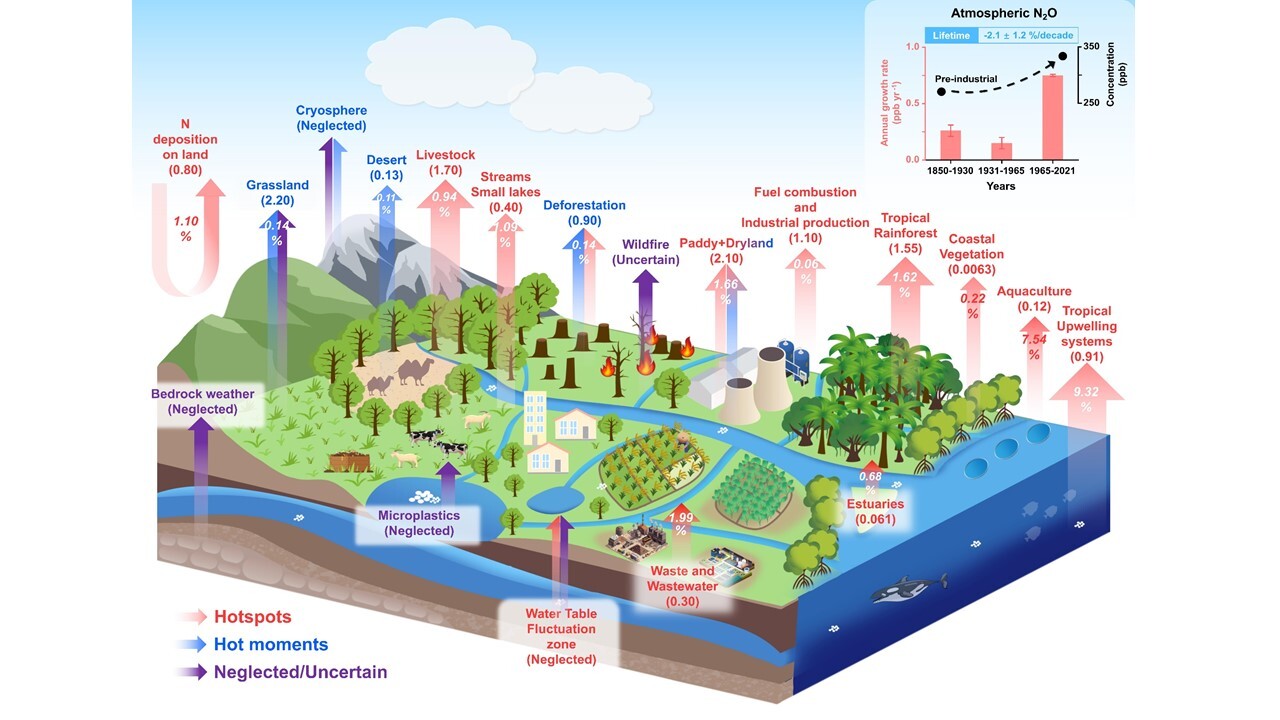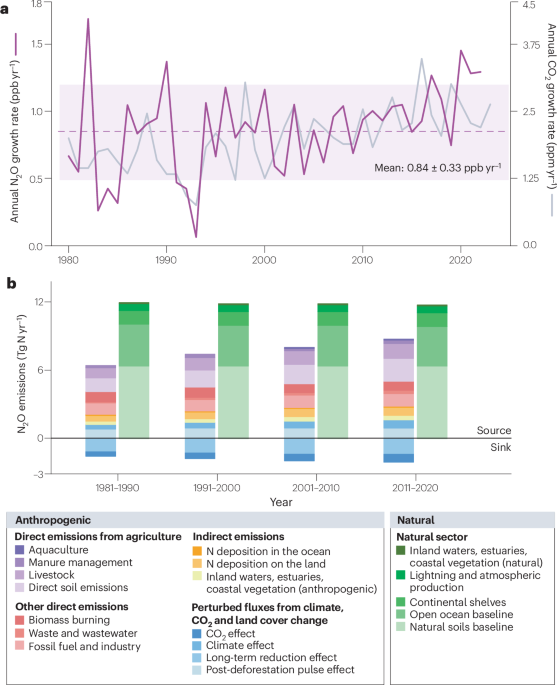Nitrous oxide sources, mechanisms and mitigation
Published in Earth & Environment and Sustainability

The story begins in 2013.
This year, we discovered that anammox hotspots could reduce N2O emissions (Ref. 1). We rapidly applied this scientific finding to practical applications by constructing five anammox hotspot projects featuring numerous anoxic-oxic interfaces (Ref. 2). Yet for years, we did not fully understand why these hotspots mitigated N2O emissions. It wasn’t until last year, when we employed the dual 15N–18O isotopic tracing method, that we uncovered in wetland systems, ammonia oxidation—particularly via the nitrifier denitrification pathway—also produces significant amounts of N2O (Ref. 3). In contrast, the anammox process consumes ammonium through anaerobic oxidation without generating N2O. In other words, by diverting a substantial amount of ammonium into anammox, the potential for N2O is sharply reduced, thereby creating the ecological effect of anammox hotspots reducing N2O emissions we had long observed.
At the same time, we can also observe that there is a continuous input of new nitrogen sources into the surface ecosystem, compelling us to consider other overlooked sources of nitrogen release. For example, bedrock represents the largest terrestrial nitrogen reservoir (Ref. 4), yet its weathering is still excluded from process-based models. Moreover, terrestrial nitrogen deposition has increased markably, triggering a redistribution of the nitrogen budget from localized point sources into the atmospheric and back to the land.
These insights underscore that the nitrogen cycle contains many unknown processes—even “mysteries”. Foremost among them is Nitrous oxide (N2O). N2O contributed to 6.4% of total grrenhouse gas-driven warming during 1750–2022, ranking third after carbon dioxide (CO2) and methane (CH4), and it is now the dominant stratospheric ozone-depleting substance. Global temperatures increases are projected to surpass 1.5 °C and potentially 2 °C by 2100, even in scenarios with immediate fossil fuel cessation, making N2O mitigation an urgent global priority (Ref. 5).
It was within this context that the motivation for this article crystallized.
But what exactly should we write about?
To answer this question, I engaged in meticulous deliberation. Last year, while recovering from Achilles tendon surgery, I finally had the uninterrupted space to reflect deeply.
Several seminal papers by Professor Tian Hanqin have already comprehensively elucidated the global N2O budget (Ref. 6 and 7). After in-depth discussions, Professor Tian advised that this manuscript should move beyond budget assessments and focus instead on strategies for N2O reduction. Conversation with Professor Zhu Yongguan led to another key realization, there are still some spatial and temporal hotspots remain underrepresented in research from an ecosystem perspective, such as some hotspots including cropland soils, tropical forests, pasture soils with animal waste return, and streams and small lakes, and hot moments including post-deforestation, upland soils after fertilizer application, and desert and grasslands after precipitation.
In terms of biogeochemical mechanisms of N2O production, I believe that ammonia oxidation, particularly nitrifier denitrification, has long been overlooked. Chemical denitrification is another pathway of interest, but current methods to quantify it are still inadequate.
From here, the second major theme of the manuscript emerged: how to mitigate N2O emissions—in other words, how to propose actionable solutions in support of the Paris Agreement. Given the complexity of the nitrogen cycle, technological interventions for N2O reduction remain underdeveloped. This manuscript synthesized the latest strategies from two complementary perspectives—reducing N2O production and enhancing N2O consumption—across aquatic, soil, and industrial ecosystems. This is, perhaps, the section I am most satisfied with.
Looking forward, we also consider future directions. In particular, the application of artificial intelligence (AI) to N2O research remains in its infancy, largely limited to meta-analyses and predictive modeling. Yet, AI offers transformative potential. On the molecular scale, AI could resolve enzyme structures, reveal quantum states in active sites and identify amino acid combinations critical for N2O generation. On the genetic scale, AI-integrated multiomics platforms could reconstruct nitrogen metabolic networks and predict gene–environment interactions. On the community scale, AI models could identify optimal microbiome compositions to reduce N2O emissions while maintaining nitrogen use efficiency. Multiscale models that integrate metagenomics, transcriptomics and enzyme kinetics with measuredN2O fluxes could finally elucidate how molecular processes manifest at ecosystem scales. I hope this article will help unlock such possibilities.
Finally, I wish to express my deepest gratitude to my co-authors-some of the most outstanding young scientists in the filed of N2O research. Our collaboration was seamless, our support for one another unwavering, and our shared learning profound. Without their expertise and commitment, this work could not have achieved its present quality.
Last but not least, I thank Senior Editor Dr. Clare Davis for her trust, and Dr. Hannah Hatcher for her close coordination, which ensured the smooth completion and publication of this manuscript for our readers.
References:
- Guibing Zhu, Shanyun Wang, Weidong Wang, Yu Wang, Leiliu Zhou, Bo Jiang, en Camp, H. J. M., Hefting M, Nils Risgaard-Petersen, Yongzhen Peng, Lorenz Schwark, Mike S.M. Jetten, Chengqing Yin. Hotspots of anaerobic ammonia oxidation at land/freshwater interfaces. Nature Geoscience. 6: 103-107.
- Guibing Zhu, Bangrui Lan, Shuci Liu, Cameron M. Callbeck, Shanyun Wang, Liping Jiang, Asheesh Kumar Yadav, Jan Vymazal, Mike S.M. Jetten, Ganlin Zhang, Yongguan Zhu. Planetary Homeostasis of Reactive Nitrogen Through Anaerobic Ammonium Oxidation. Engineering. Volume 38, 175-183, 2024
- Shanyun Wang, Bangrui Lan, Longbin Yu, Manyi Xiao, Liping Jiang, Yu Qin, Yucheng Jin, Yuting Zhou, Gawhar Armanbek, Jingchen Ma, Manting Wang, Mike S. M. Jetten, Hanqin Tian, Guibing Zhu, Yong-Guan Zhu. Ammonia oxidation is a global source of nitrous oxide in streams. Nature Communications. (2024) 15:4085. https://doi.org/10.1038/s41467-024-48343-9
- Houlton, B. Z., Morford, S. L. & Dahlgren, R. A. Convergent evidence for widespread rock nitrogen sources in Earth’s surface environment. Science 360, 58–62 (2018).
- Clark, M. A. et al. Global food system emissions could preclude achieving the 1.5° and 2°C climate change targets. Science 370, 705–708 (2020).
- Tian, H. et al. Global nitrous oxide budget (1980–2020). Earth Syst. Sci. Data 16, 2543–2604 (2024).
- Tian, H. et al. A comprehensive quantification of global nitrous oxide sources and sinks. Nature 586, 248–256 (2020).
Follow the Topic
-
Nature Reviews Earth & Environment

An online-only journal publishing high-quality Review, Perspective, and Commentary articles across the entire spectrum of Earth and environmental sciences.
What are SDG Topics?
An introduction to Sustainable Development Goals (SDGs) Topics and their role in highlighting sustainable development research.
Continue reading announcement

Please sign in or register for FREE
If you are a registered user on Research Communities by Springer Nature, please sign in
In this Review, we outline global N2O sources, with a focus on hotspots and hot moments, and discuss strategies to mitigate N2O emissions. N2O can be released by natural sources such as bedrock weathering, but anthropogenic sources such as agriculture account for 40% of total emissions. Hotspots are localized regions of high emissions and include cropland soils (2.1 Tg N yr−1), tropical forests (1.55 Tg N yr−1), pasture soils with animal waste return (1.7 Tg N yr−1), and streams and small lakes (0.4 Tg N yr−1). Brief periods of intense emissions, known as hot moments, include post-deforestation, upland soils after fertilizer application, and desert and grasslands after precipitation. N2O production from terrestrial and aquatic environments is mainly driven by two microbial processes: nitrification and denitrification. Bioaugmentation and biogeoengineering technologies hold potential for reducing N2O emissions; for example, nature-based anammox hotspot geoengineering in Jiaxing, China, reduces N2O emissions by 27.1%. However, the spatiotemporal heterogeneities and different production pathways of N2O emissions are poorly represented in existing models, hindering the quantification and mitigation of emissions. A global N2O database is needed to address this limitation. Additionally, artificial intelligence technology could enable real-time agricultural management to align nitrogen supply with crop demand.